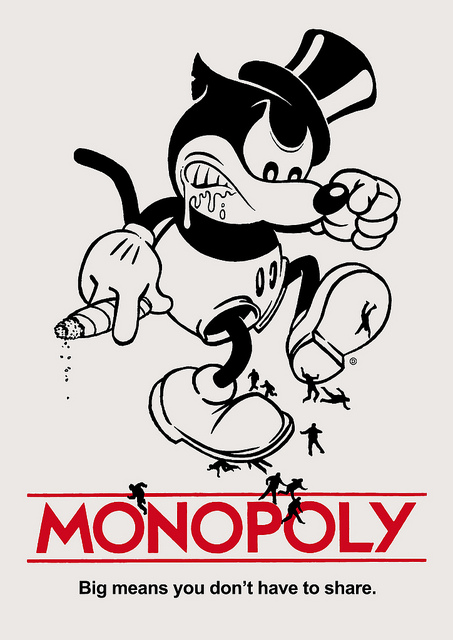11.13: Monopolies
- Page ID
- 48430
Learning Objectives
- Describe the characteristics of a monopoly
Introduction to Monopoly

If perfect competition is a market where firms have no market power and they simply respond to the market price, monopoly is a market with no competition at all, and firms have complete market power. In the case of monopoly, one firm supplies all of the output in a market. Since a monopoly faces no significant competition, it can charge any price it wishes. While a monopoly, by definition, refers to a single firm, in practice the term is often used to describe a market in which one firm merely has a very high market share. For example, in 2013, Microsoft’s Windows operating system ran on more than 90% of the most commonly sold personal computers. This tends to be the definition that the U.S. Department of Justice uses.
Even though there are very few true monopolies in existence, we do deal with some of those few every day, often without realizing it: the U.S. Postal Service, your electric and garbage collection companies are a few examples. Some new drugs are produced by only one pharmaceutical firm—and no close substitutes for that drug may exist.
From the mid-1990s until 2004, the U.S. Department of Justice prosecuted the Microsoft Corporation for including Internet Explorer as the default web browser with its operating system. The Justice Department’s argument was that, since Microsoft possessed an extremely high market share in the industry for operating systems, the inclusion of a free web browser constituted unfair competition to other browsers, such as Netscape Navigator (now only a browser of the past). Since nearly everyone was using Windows, including Internet Explorer eliminated the incentive for consumers to explore other browsers and made it impossible for competitors to gain a foothold in the market.
MOnopolies and History

In spring 1773, the East India Company, a firm that, in its time, was designated “too big to fail,” was experiencing financial difficulties. To help shore up the failing firm, the British Parliament authorized the Tea Act. The act continued the tax on teas and made the East India Company the sole legal supplier of tea to the American colonies. By November, the citizens of Boston had had enough. They refused to permit the unloading of tea, citing their main complaint: “No taxation without representation.” Several newspapers, including The Massachusetts Gazette, warned arriving tea-bearing ships, “We are prepared, and shall not fail to pay them an unwelcome visit by The Mohawks.”
Step forward in time to 1860—the eve of the American Civil War—to another near monopoly supplier of historical significance: the U.S. cotton industry. At that time, the Southern states provided the majority of the cotton Britain imported. The South, wanting to secede from the Union, hoped to leverage Britain’s high dependency on its cotton into formal diplomatic recognition of the Confederate States of America.
This leads us to this module’s topic: a firm that controls all (or nearly all) of the supply of a good or service—a monopoly. How do monopoly firms behave in the marketplace? Do they have “power?” Does this power potentially have unintended consequences? We’ll return to this case at the end of the module to see how the tea and cotton monopolies influenced U.S. history.
How Monopolies Form: Barriers to Entry
Because of the lack of competition, monopolies tend to earn significant economic profits. These profits should attract vigorous competition, like the firms we discussed already in perfect competition, and yet, because of one particular characteristic of monopoly, they do not. Barriers to entry are the legal, technological, or market forces that discourage or prevent potential competitors from entering a market. Barriers to entry can range from the simple and easily surmountable, such as the cost of renting retail space, to the extremely restrictive. For example, there are a finite number of radio frequencies available for broadcasting. Once the rights to all of them have been purchased, no new competitors can enter the market.
In some cases, barriers to entry may lead to monopoly. In other cases, they may limit competition to a few firms. Barriers may block entry even if the firm or firms currently in the market are earning profits. Thus, in markets with significant barriers to entry, it is not true that abnormally high profits will attract new firms, and that this entry of new firms will eventually cause the price to decline so that surviving firms earn only a normal level of profit in the long run.
There are two main types of monopolies that differ in they ways they exploit barriers of entry: natural monopolies and legal monopolies. We’ll learn more about these next.
Glossary
[glossary-page][glossary-term]barriers to entry:[/glossary-term]
[glossary-definition] the legal, technological, or market forces that may discourage or prevent potential competitors from entering a market[/glossary-definition][glossary-term]monopoly:[/glossary-term]
[glossary-definition] a situation in which one firm produces all of the output in a market[/glossary-definition][/glossary-page]
- Introduction to a Monopoly. Authored by: OpenStax College. Located at: https://cnx.org/contents/vEmOH-_p@4.40:cpTA15KJ@5/Introduction-to-a-Monopoly. License: CC BY: Attribution. License Terms: Download for free at http://cnx.org/contents/bc498e1f-efe...569ad09a82@4.4

